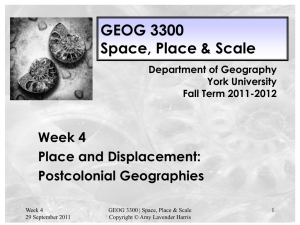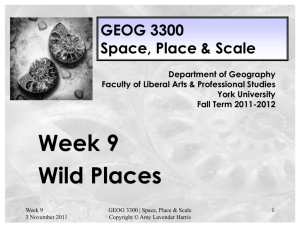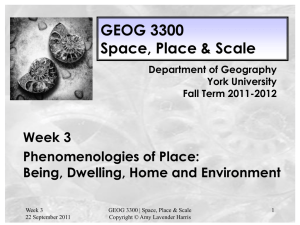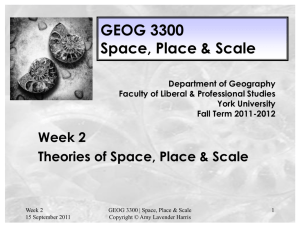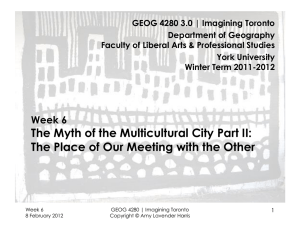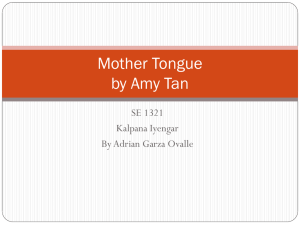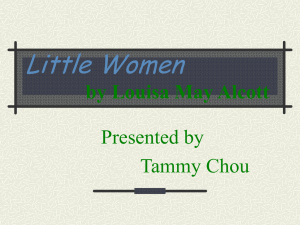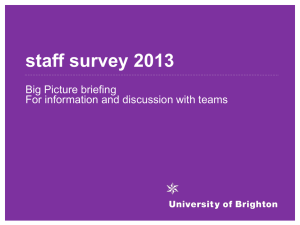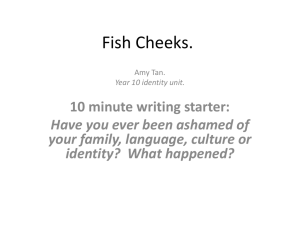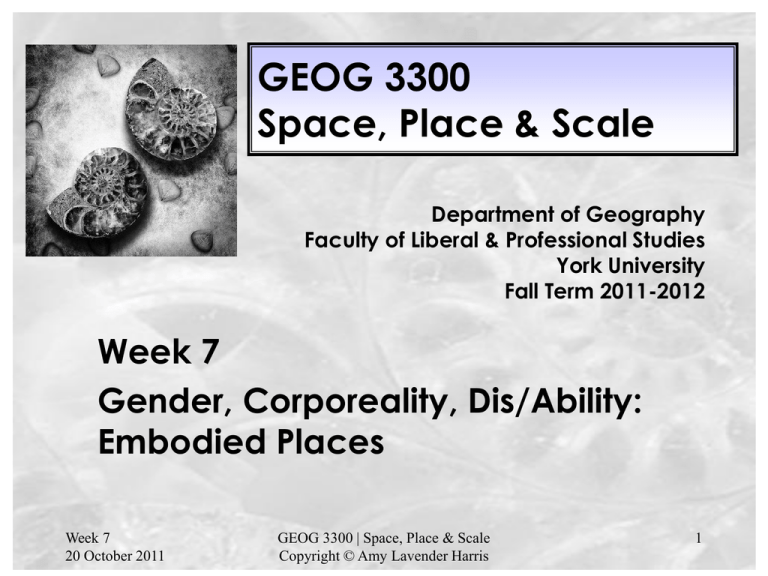
GEOG 3300
Space, Place & Scale
Department of Geography
Faculty of Liberal & Professional Studies
York University
Fall Term 2011-2012
Week 7
Gender, Corporeality, Dis/Ability:
Embodied Places
Week 7
20 October 2011
GEOG 3300 | Space, Place & Scale
Copyright © Amy Lavender Harris
1
Embodied Space …
• “Being is round,” asserts the French phenomenologist Gaston
Bachelard in The Poetics of Space (1958; 1964). Bachelard points
to the body’s immediacy, the centre of experience, the
roundness of the earth, the curved edge of the horizon.
• Yi-Fu Tuan: “the objects we perceive are commensurate with the
size of our body, the acuity and range of our perceptual
apparatus, and purpose.” (Topophilia, 1974: 14). We measure the
world against ourselves.
• The body is spatialized, but space too is corporeal. Remember
Casey on space and being as being ‘mutually co-constitutive?’
• These perspectives (above) are implicitly phenomenological
(phenomenology = consciousness + experience +
inter/subjectivity).
• How might embodied space also be socially constructed?
Week 7
20 October 2011
GEOG 3300 | Space, Place & Scale
Copyright © Amy Lavender Harris
2
… is complex, contested,
multiple, and corporeal
•
•
•
•
•
“Corporeality:” deriving its reality from the body.
Like the meaning of place, the meaning of the body has tended to be
taken for granted.
And yet (like place), ‘body’ may refer to a number of different things:
– A biological entity (the physical body)
– A person (a social or legal entity)
– A group (conceptual: e.g., “body” of work; or women’s bodies; or
disabled bodies)
Bodies are inherently spatialized:
– A body signifies (physical) presence
– A body signifies boundaries (self/other; here/there) and suggests
rights, possession, power … and violence, transgression, oppression,
and resistance too
Like space/place, the body is a complex, contradictory, and contested
concept
Week 7
20 October 2011
GEOG 3300 | Space, Place & Scale
Copyright © Amy Lavender Harris
3
The Socially Constructed Body
• The body as a discourse (Longhurst; Foucault)
• Bodies as “primary objects of inscription – surfaces upon
which values, morality and social laws are inscribed.”
(Longhurst, 1997: 489); bodies as “discursively produced.”
• Things we perceive as ‘real’ differences – in gender,
sexuality, ability – are in fact social constructions imposed
on the body. What makes a body more (or less) able?
Renowned physicist Stephen Hawking, for example?
• A continuum: between essentialism (that bodies, and
differences between bodies, are ‘real’ and ‘natural’) and
constructionism (that bodies are wholly representational
objects) Feminists too populate this entire continuum.
Week 7
20 October 2011
GEOG 3300 | Space, Place & Scale
Copyright © Amy Lavender Harris
4
Gendered Bodies: In and Out of Place
• Male (white, able) body: possessor, territory, outside,
public, empire, dominance
• Female (non-white, dis/abled) body: possessed, passive,
domestic, inside, private, submissive, ‘natural’, wild, exotic.
• “Woman is / man does” claims.
• Men transcend space (and the body); women as prisoners
of place (and their bodies).
• The abstract body within ‘spatial science’; e g., medical
geography (Longhurst’s example: geographers tracking
viruses rather than the bodies that carry them): place as
disembodied.
• “the body as geography’s Other” (Longhurst, 493)
Week 7
20 October 2011
GEOG 3300 | Space, Place & Scale
Copyright © Amy Lavender Harris
5
Dis/abled Bodies: In and Out of Place
• Rob Kitchin on the “distinct spatiality” of disability.
• “spaces are currently organised to keep disabled people
`in their place’”
• At the same time, “spaces are social texts that convey to
disabled people that they are `out of place’
• Marxist approach challenges notions that a disabled
person is inherently “unproductive” (rooted in notion that
disability is an individual rather than social challenge)
• Psychoanalysis: fear of the ‘Other.’
• How exclusion is produced and reproduced spatially
• Accessibility as a template for accommodating: children,
elderly, women, ‘Others’ of all varieties.
Week 7
20 October 2011
GEOG 3300 | Space, Place & Scale
Copyright © Amy Lavender Harris
6
Geographical Impacts
• Impact on what subjects are considered appropriate for
geographical study, and how they should be studied (e.g.,
studies of embodiment, sexuality, bodily homelessness,
violence historically suppressed in favour of “the lean, the
clinical, the quantitative, the heroic and the scientific.” ).
• As a result, geography risk(ed) fixating on “white,
bourgeois, able-bodied men.” (Longhurst, 494).
• Other impacts: ‘naturalizing’ spatial boundaries, mobility,
domesticity, safety and security, freedom to explore.
• “A woman’s place” …?
• Contemporary research, however, uses these forms of
difference to open up new subjects and perspectives
Week 7
20 October 2011
GEOG 3300 | Space, Place & Scale
Copyright © Amy Lavender Harris
7
What can Embodied
Geographies Do?
• They can rupture dualisms
• Challenge ideas about boundaries (body/world,
self/other)
• Invite inclusion of non-dominant perspectives: female,
‘natural’, eastern, black, poor, disabled (and can facilitate
the rewriting of all these concepts; e.g.,
gender/sex/sexuality)
• But: they can also entrench the existing dualities if they
merely elevate ‘Others’ (e.g., woman = nature = nurturing
= good) without challenging this mathematic
Week 7
20 October 2011
GEOG 3300 | Space, Place & Scale
Copyright © Amy Lavender Harris
8
What else can they do?
• Remember Cresswell’s ‘genealogy of place’?
• Most geographers concerned with embodiment rely on
phenomenological (various) or social constructionist
insights/perspectives (very various)
• Inevitably, phenomenological and (especially) social
constructionist perspectives challenge and re-write
descriptive approaches to place. How?
• One thing they do is show us that even the ‘descriptive’ is
not so straight-forward, that it is informed by values and
relations of power and privilege.
• Reminder: all three approaches have benefits, too (even
the descriptive … how?)
Week 7
20 October 2011
GEOG 3300 | Space, Place & Scale
Copyright © Amy Lavender Harris
9
Project:
Constructing Geographies
of Disability
Week 7
20 October 2011
GEOG 3300 | Space, Place & Scale
Copyright © Amy Lavender Harris
10
Geographical Approaches to
Disability
Phenomenological
or Humanist
Social
Constructionist
-Body/place are ‘real’,
measurable, and
quantifiable
-Disability issues are
physical problems
requiring material
solutions
-the lived body is at the
centre of geographical
experience/meaning
--disabled people’s
experiences of place are
unique and individual
and particular
-(Marxism): the body is a
product of relations of
class, capital, and
production
-(feminism, discouse
analysis): the body is
discursively produced /
body as text
-Measurement,
assessment, policy,
prescription
-reliance on
experts/professionals
-Experiences, narratives,
stories
-Meaning may be
derived through narrative
analysis
-Social justice
-Laying bare power,
privilege
-Representation
-Activism … revolution?
Descriptive
Perspective on
Body/Place
Methods and Tools
Outcomes?
Week 7
20 October 2011
GEOG 3300 | Space, Place & Scale
Copyright © Amy Lavender Harris
11
Your Task
•
•
•
•
Three (3) groups of no more than 9 people each
Group A: descriptive approach to disability
Group B: phenomenological/humanist approach
Group C: social constructionist approach
• You are a team of consultants hired to do an accessibility
audit of the TEL Building
• Each group has one hour to identify five (5) challenges
and five (5) resolutions to accessibility issues in the TEL
Building. Think carefully about what tools you’ll use in
conducting your audit and what kinds of ‘fixes’ you’ll
imp0lement
Week 7
20 October 2011
GEOG 3300 | Space, Place & Scale
Copyright © Amy Lavender Harris
12
Things to Consider:
• What is ‘disability’? How do ‘disability’ and ‘place’
intersect? What does it mean for a space to be truly
‘accessible?’
• Will you come up with a plan? A story? A manifesto? An
intervention? A guerilla action (e.g., an occupation)? A
policy?
• How will you go about testing or implementing your
approach? (it is okay to design a study or intervention that
might be carried out in greater detail later)
• What are the challenges, limitations, and advantages of
your group’s approach to / perspective(s) on disability
and place?
• How do they encourage you to think differently about
place?
Week 7
20 October 2011
GEOG 3300 | Space, Place & Scale
Copyright © Amy Lavender Harris
13
Outcome
• After an hour, we will regroup and talk about how encountering
disability in a particular place changes our experience and
understanding of that place. We’ll also consider how this
knowledge might be extended.
• The objective is to link geographical theory and practice
• Praxis: “a complex activity by which individuals create culture
and society, and become critically conscious human beings.
Praxis comprises a cycle of action-reflection-action which is
central to liberatory education. Characteristics of praxis include
self-determination (as opposed to coercion), intentionality (as
opposed to reaction), creativity (as opposed to homogeneity),
and rationality (as opposed to chance).” (after Paulo Friere,
theorist of education)
Week 7
20 October 2011
GEOG 3300 | Space, Place & Scale
Copyright © Amy Lavender Harris
14
Midterm Exam
•
•
•
•
Midterm exam next week: 27 October 2011
Two hour in-class exam
Closed book: no notes or other aids
Coverage: first half of the term; emphasis on the core
concepts (especially different approaches to space,
place & scale: descriptive, phenomenological, social
constructionist – including postcolonial, gendered, and
class-based (Marxist) perspectives)
• Yes, the course readings matter and will form the basis for
certain questions.
• Emphasis: thought and analysis, not regurgitation of facts
Week 7
20 October 2011
GEOG 3300 | Space, Place & Scale
Copyright © Amy Lavender Harris
15
Midterm Exam Format
• Worth 20% of your final grade (20 marks)
• Two parts:
Part A: Longer essay question (no choice) asking you to analyse
a particular space in the context of Cresswell’s three main
approaches to space/place. This question will be worth 10
marks.
Part B: 2 shorter answers (choose from 3 or 4) asking more
specific questions derived from readings, theoretical
perspectives, lectures, etc. Each of these questions will be
worth 5 marks, for a total of 10.
• Answers should be detailed, coherent, and written in complete
and legible sentences.
• Budget your time wisely (suggestion: an hour for Part A; 30
minutes for each answer in Part B)
Week 7
20 October 2011
GEOG 3300 | Space, Place & Scale
Copyright © Amy Lavender Harris
16
Approach
Descriptive
Phenomenological
Social Constructionist
Week 4
24 January 2008
Associated
Schools
Preoccupations with Place
-Regional Geography
(Richard Hartshorne)
-Early cultural
geographers (Carl Sauer)
-Spatial Science (1970s)
-‘ideographic’
-‘chorology’
-Regions and cultures
-Place as a thing: ontologically given
-Environmental determinism (although Sauer held that
culture transforms nature)
-‘Place’ remains largely undefined
Phenomenology
(Heidegger, MerleauPonty, Bachelard)
-Humanistic geographers
(Yi-Fu Tuan, Anne
Buttimer, David Seamon,
Ted Relph, Edward
Casey)
-experienced, ‘embodied’ or lived place
--’topophilia’ (Tuan)
-Home and dwelling
-belonging and attachment
-‘authenticity’
Place as primordial or Place as “mutually constituted”
by environment and culture
-‘romantic’? Naïve?
1. Postcolonial
--poststructuraliand postmodern perspectives
Approaches (race and
-Social determinism: places as socially constructed
culture): Said, Bhabha
-Spatial ‘turn’ in the cultural and social sciences
2. Feminism and
-Class, gender and race
Embodied approaches
-Transgression and resistance; power and privilege
(gender, corporeality):
-Postcolonial legacies
Gillian Rose, Doreen
Massey
-‘ungrounded? Incoherent?
3. MarxismGEOG
(class):
David
-What
happens
3300
| Space,
Place
& Scaleto ontology?
17
Harvey,Copyright
Lefebvre © Amy Lavender Harris, 2008

